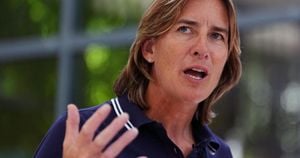The highly anticipated film adaptation of Wicked has not only captured the hearts of audiences but also sparked curiosity about its enchanting filming locations and production details. Directed by Jon M. Chu, known for his knack for vibrant storytelling, Wicked transports viewers to the magical Land of Oz, showcasing remarkable sets and elaborate designs. The movie, based on the beloved Broadway musical and Gregory Maguire's novel, dives deep to reveal the backstory of two iconic characters, Elphaba and Glinda.
Filming primarily took place across various stunning locations in the United Kingdom, with Sky Studios Elstree serving as the film’s main hub. Situated just outside of London, this state-of-the-art studio boasts 12 soundstages, allowing the production team to bring their grand vision to life. Yet, the scope of the project required even more space. The filmmakers relied on additional facilities, such as Warner Bros. Studios Leavesden and Elstree Studios, making the most of 17 soundstages and four major backlots to recreate the world of Oz.
One of the standout design features is Munchkinland, where the filmmakers executed their vision spectacularly. Built near the village of Ivinghoe, just outside Luton, the team constructed colorful cottages and the iconic Yellow Brick Road. To fully immerse viewers, they planted nine million tulips across Norfolk, crafting breathtaking backdrops for Munchkinland scenes. The tulips served not just as decoration but as building materials for the Munchkins' homes post-production, showcasing the innovative approaches the team embraced.
Not every scene was shot entirely within studio walls. The arrival of the entitled Glinda at Shiz University, which features quite the lavish spectacle, was filmed at Seven Sisters Country Park. The dramatic chalk cliffs of East Sussex added to the grandeur of the Land of Oz, reinforcing the whimsical nature of the storyline as Glinda sails on her pink boat.
The scale of the sets was another talking point among production staff. Nathan Crowley, the production designer, equated the experience to building cities, with structures towering as high as 50 feet. These expansive sets not only allowed for stunning visuals but also limited the need for blue-screen technology, giving the film's fantasy world an authentic feel. Crowley stated, "They were the biggest sets I have ever created," emphasizing the massive scale of the project.
The creative team started construction on several sets like Shiz University, which reportedly required around 20 weeks to complete. The university features architectural styles blending Italianate and Moorish designs, making it visually unique and functional as Elphaba and Glinda’s meeting place.
Glinda's dorm room also showcased creativity and whimsical design elements. It depicted traditional clutter, with her vibrant luggage doubling as closet space. Each piece of luggage reveals delightful surprises within, filled with her usual pink ensemble. Chu remarked, "For Elphaba to go through this maze was just really fun," demonstrating how the interplay of their contrasting personalities was integrated humorously.
The film's production team didn't stop at just beautiful landscapes and designs. An iconic scene features Elphaba and Glinda boarding their train to Oz—an extraordinary creation. With exaggerated proportions and unique aesthetics, the train reportedly weighed around 50 tons, emphasizing the ambitious nature of the filmmakers' vision. The train’s features, such as golden gears, drew viewers with its enchanting yet steampunk-like quality. Chu jokingly remarked about the train's immense weight and logistics, comparing it to moving mountains.
Even the smaller characters received grand treatment. The mechanized bust of the Wizard, performed by Jeff Goldblum, was crafted through an innovative 3D scan of the actor's face. The design includes multiple moving parts, adding to the mystique of his character. Such dedication to detail paints Wicked not just as another film but as an immersive experience.
Fans and critics alike have marveled at how these unique locations and designs come together to form the fantastical world of Oz. With its vibrant and cultural references, Wicked has reinvigorated the filmmaking scene. The production choices reflect not just artistic ambitions but a commitment to storytelling and immersive world-building.
With Wicked: Part One now captivating audiences, it’s clear the creative team’s extensive efforts paid off. They didn’t merely recreate Oz; they brought it to life, delivering breathtaking visuals and enchanting storytelling. With such rich environments and dazzling stories, it’s easy to get lost in the magic of it all. Theatergoers and film lovers alike are left pondering what wonders the second part of Wicked will reveal.



